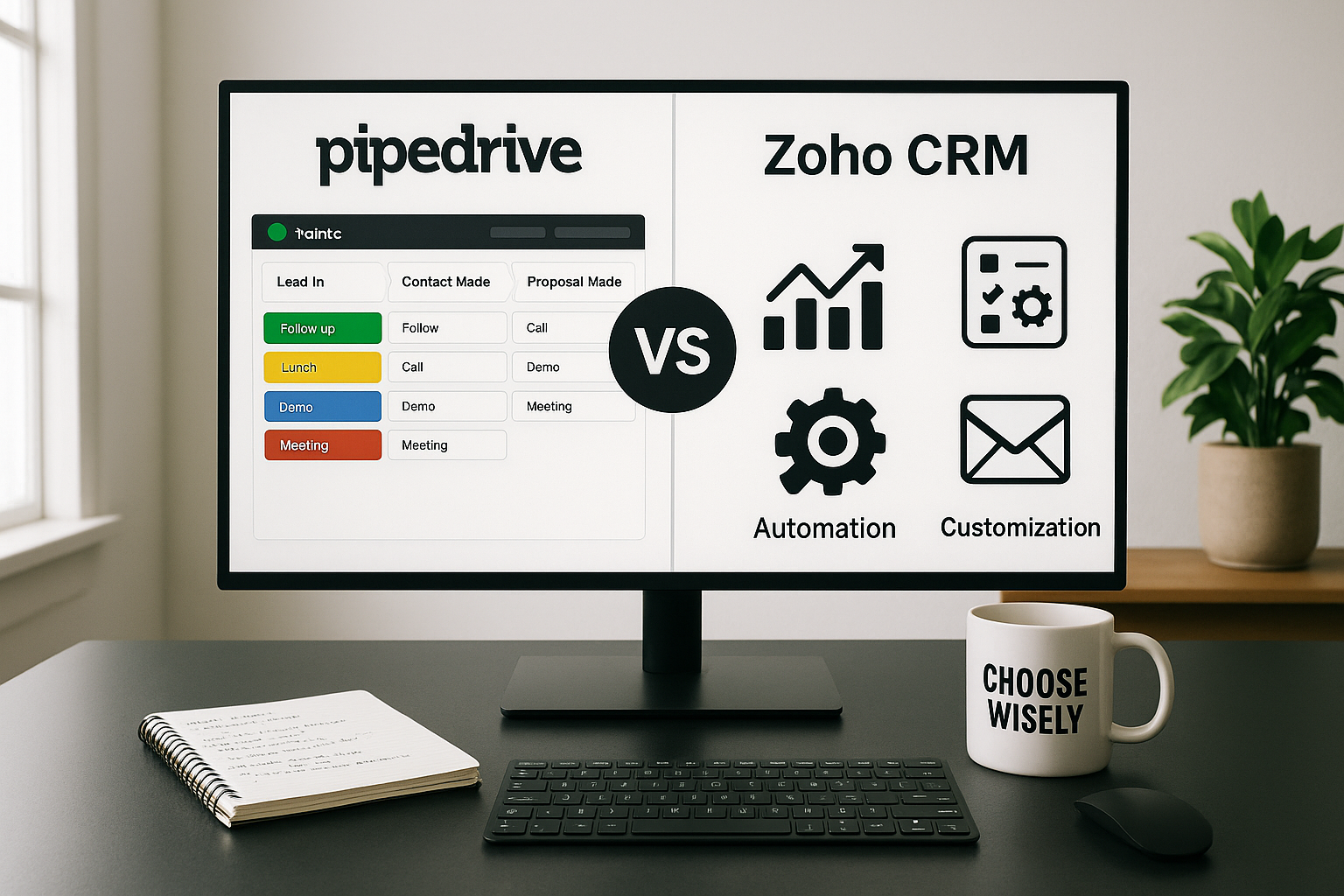ActiveCampaign vs Mailchimp: Brief Comparison Table
Here's a quick comparison table to get you started, but continue reading for more information about details about each platform.
| Criteria |
ActiveCampaign |
Mailchimp |
| Description |
A comprehensive automation system that combines email marketing, marketing automation, CRM, and advanced machine learning to effectively manage, segment, and personalize across multiple channels. Additionally, it can automate sales and support tasks, streamlining processes for enhanced efficiency. |
Mailchimp is a versatile marketing platform that empowers businesses to create, send, and automate email campaigns. It provides a range of tools for email marketing, audience segmentation, automation, and analytics, making it a popular choice for businesses to engage their audience effectively. |
| Best for |
Companies that intend to expand their email marketing to incorporate CRM, e-commerce integrations, and various automation techniques. |
Small to medium-sized e-commerce businesses that require email marketing in addition to website hosting. |
| Features |
More extensive, comprehensive, and advanced. |
Basic, easy to use, but also useful. |
| Customer Support |
It provides chat and email support across all plans, reserving phone support for Enterprise plan subscribers. |
Paid plans get 24/7 email and chat assistance, while Premium plans have phone support. On the Free plan, you get email assistance for the first 30 days. |
| Pricing |
|
|
ActiveCampaign vs MailChimp: User-friendliness
 Mailchimp's popularity partly arises from its reputation as an uncomplicated option in the realm of complex email marketing software. It provides an interface that's easy to navigate and a drag-and-drop email editor that's user-friendly. However, some of Mailchimp's features might not always be where you expect them. For instance, automations, landing pages, and forms are all housed under the "Campaigns" tab, which might seem a bit counterintuitive.
Mailchimp's popularity partly arises from its reputation as an uncomplicated option in the realm of complex email marketing software. It provides an interface that's easy to navigate and a drag-and-drop email editor that's user-friendly. However, some of Mailchimp's features might not always be where you expect them. For instance, automations, landing pages, and forms are all housed under the "Campaigns" tab, which might seem a bit counterintuitive.
Both platforms face a challenge when it comes to importing contacts. They support only CSV files, meaning you need to manually convert XLS or TXT files before importing. Leading competitors streamline this process by supporting various file formats, including XLS, TSV, CSV, and TXT.
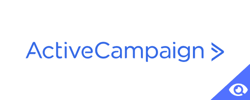 ActiveCampaign boasts a more extensive feature set compared to Mailchimp, so mastering its functionalities may take a bit more time and practice. While ActiveCampaign's interface and drag-and-drop editor are well-designed, newcomers to email marketing might find the overall experience a bit overwhelming.
ActiveCampaign boasts a more extensive feature set compared to Mailchimp, so mastering its functionalities may take a bit more time and practice. While ActiveCampaign's interface and drag-and-drop editor are well-designed, newcomers to email marketing might find the overall experience a bit overwhelming.
In terms of user-friendliness, this round wins Mailchimp. Its ease of use and beginner-friendly approach make it a more accessible option compared to the slightly more complex ActiveCampaign.
ActiveCampaign vs MailChimp: Key Features
Email Campaigns
Creating impactful email campaigns is made easier with the aid of both ActiveCampaign and Mailchimp. To delve into the core of each platform's email marketing offerings, let's explore their foundational features.
Both tools share crucial elements like templates, marketing automation, segmentation, and more. However, Mailchimp has an edge in user-friendliness, tailoring these features to suit the needs of small businesses. This accessibility empowers small business owners, eliminating the necessity for extensive training in email marketing. In contrast, ActiveCampaign presents a steeper learning curve, making it a fitting choice for seasoned marketers.
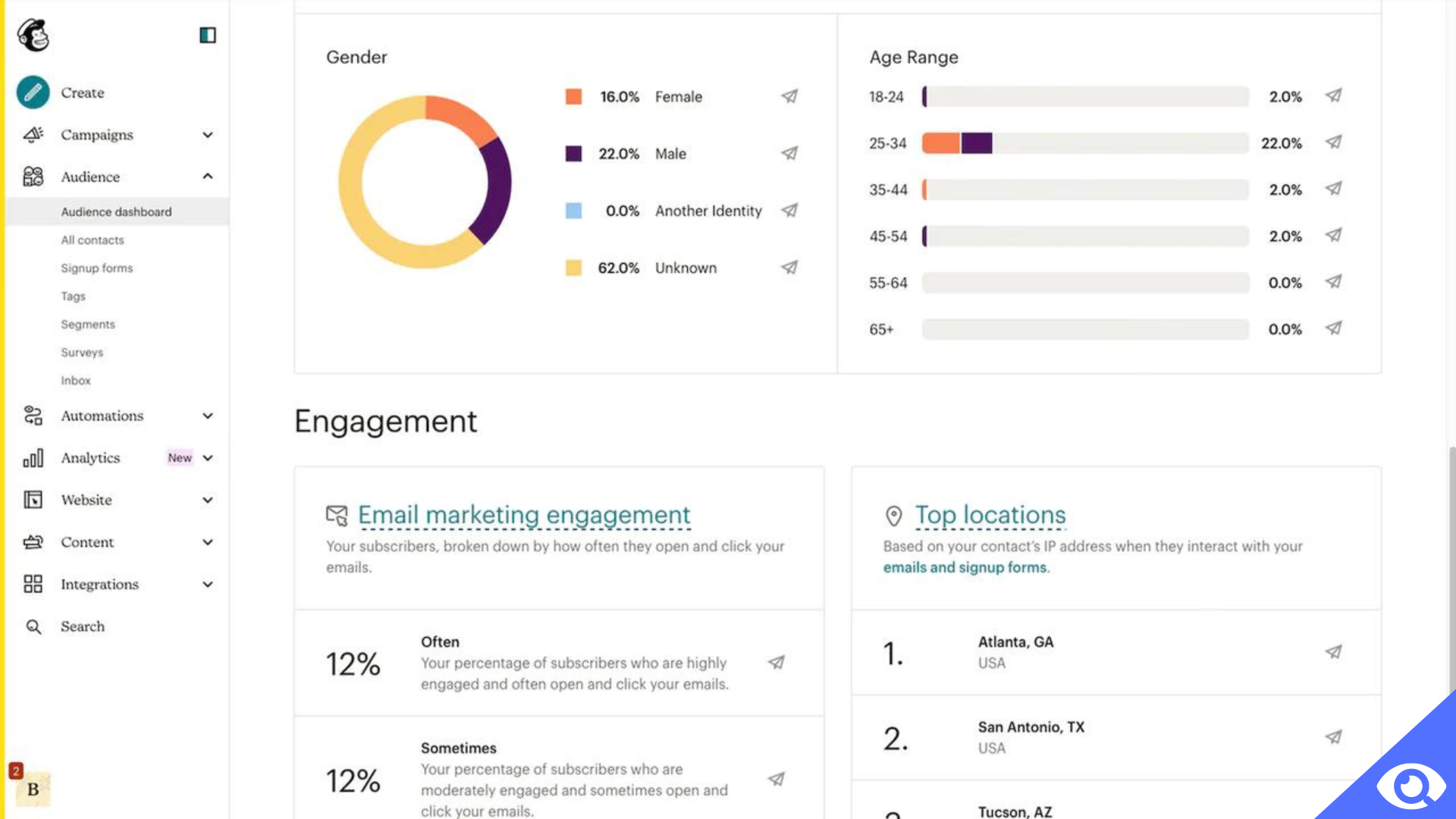
Mailchimp's interface boasts seamless navigation, accompanied by a user-friendly drag-and-drop editor for creating visually appealing emails. However, the downside lies in Mailchimp's free plan, which offers basic email templates. The transition to paid plans unlocks a treasure trove of over 100 pre-designed email templates, adjustable for diverse subjects.
ActiveCampaign takes it up a notch with a wider selection of email templates, exceeding 250, all customizable for your unique needs. Its email editor is intuitive and easy to grasp. Nevertheless, navigating its automation settings might be challenging. As an alternative to Mailchimp, ActiveCampaign offers strong email marketing automation capabilities, including triggers to dispatch emails based on client interactions with your website or business. This dynamic feature facilitates the creation of personalized email campaigns, fostering increased conversions.
In general, ActiveCampaign is more useful if you're open to investing time in mastering its intricacies. Fortunately, the platform equips you with valuable resources and tutorials for a smooth start.
On the other side, Mailchimp offers an easier learning curve, but its features aren't as advanced. For larger enterprises with extensive email marketing demands, a more feature-rich solution might be more suitable. The choice between these two email marketing tools should align with your business's distinct needs, ensuring a tailored and impactful approach.
ActiveCampaign
4.5
Marketing Automation
Mailchimp's capabilities, while impressive in terms of email automation, are overshadowed by ActiveCampaign's robust features. Yet, let's not undermine Mailchimp's potential, which remains powerful and suitable for most small enterprises. The distinction lies in the expansive scope that ActiveCampaign offers.
ActiveCampaign improves your automation efforts by enabling the creation of sophisticated workflows including email circulation, lead generation, data segmentation, and etc.
Remarkably, ActiveCampaign facilitates exporting a subscriber list marked by specific link interactions, a strategic boon for effective remarketing efforts. Here's where ActiveCampaign extends further: it introduces an SMS marketing channel that you can use in your automated campaigns and on your website messages.
Mailchimp, in contrast, presents fundamental trigger automation options, such as opened email triggers and abandoned cart triggers. Yet, its automation editor lacks the flexibility to set your automation triggers to go down different paths. Although Mailchimp includes SMS marketing, integrating it into your automation journey requires a third-party tool.
Both platforms contribute A/B testing capabilities, pivotal for scrutinizing email marketing campaign efficacy. However, Mailchimp's split tests come with limitations as you can only test your automation campaigns based on the number of contacts.
ActiveCampaign has a valuable function named Automations Map. This visualization tool empowers users to track and comprehend automation interactions, enriching your automation strategy. This feature, accessible in the Plus, Professional, and Enterprise plans, enhances your grasp of automation's impact. The map shows the interconnected web of automation workflows, whether it’s through goals, deals, tags, or more. This insight explains each workflow's significance, nurturing a profound understanding of its business effects.
In this ActiveCampaign vs. Mailchimp comparison, ActiveCampaign leads the charge. Its streamlined approach and diverse automation options set it apart as a robust choice.
[Related Article: HubSpot vs Mailchimp]
Email List Building
Creating a big list of email subscribers is a key part of successful email marketing. ActiveCampaign and Mailchimp both offer strong tools to help marketers grow their list of subscribers.
Let's delve into the details of how each tool helps you build your list.
Mailchimp has a user-friendly tool for making landing pages, and it's available even in their free plan. These pages have forms that can easily integrate with your website and adapt to different needs.
ActiveCampaign takes it a step further by offering landing pages as an extra feature you can get with their paid plans. The forms you make with ActiveCampaign are more convenient than Mailchimp's. No matter which template you choose, your forms will look good on mobiles and other devices.
Mailchimp's forms, however, don't adapt as well to different screens. You need to be careful about their size to make sure they work on all devices.
ActiveCampaign brings in a smart feature called lead scoring. This feature rates how likely each potential customer is to buy. With this, you can build a list that's high in quality, focusing your energy on those who are more likely to turn into real customers. It helps you make the most of your efforts.
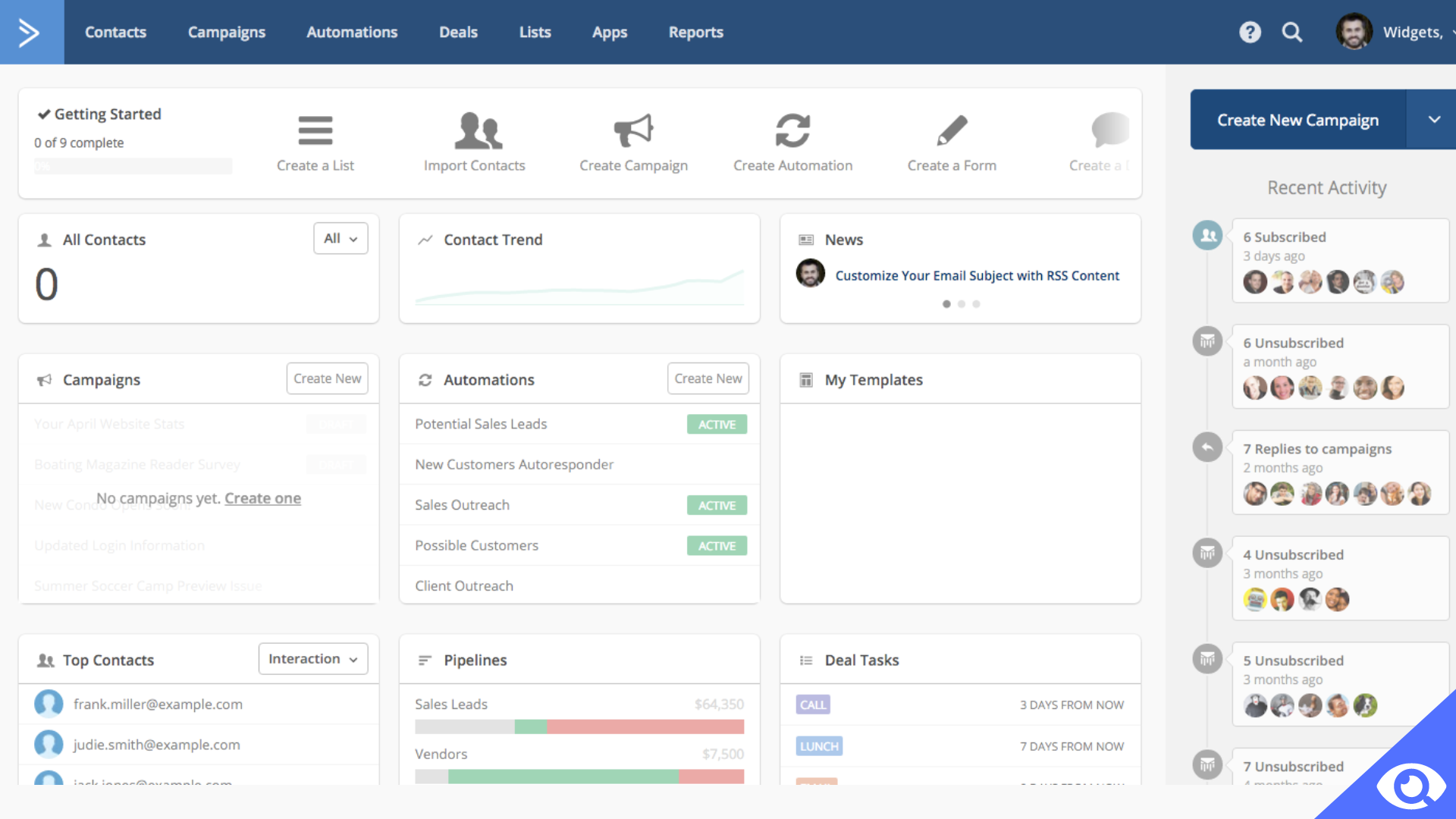
Audience Segmentation
When you send emails to your list of contacts, you want to make sure they are in the right inbox. A good email marketing tool should let you divide your audience based on factors like user behavior, location, age, and more.
Both ActiveCampaign and Mailchimp offer ways to segment your audience, making your email campaigns more personalized. Let's explore how ActiveCampaign achieves this.
With ActiveCampaign, you have options for segmenting your email contacts: lists, segments, and custom fields. These help you tailor your email campaigns to a broader audience or a more specific group.
Lists are the broadest category, where you group contacts based on the type of emails you plan to send, like announcements, promotions, or networking.
Tags are more precise. They let you create smaller groups within your contacts for targeted email campaigns.
Custom fields are the most detailed segmentation. You use them to store specific information about each contact, such as names, birthdays, or phone numbers. This data is collected when customers fill out forms on your website.
ActiveCampaign's segmentation process is simple, much like Mailchimp's straightforward one-condition approach.
However, Mailchimp becmes a bit trickier when you want to create segments with multiple conditions. Its options are somewhat limited. In Mailchimp, a contact can be included in only one list for an email campaign. If you segment your list and include a contact in multiple segments, you end up paying for that contact twice, since Mailchimp charges per subscriber.
This is where ActiveCampaign has an advantage. It lets you run the same campaigns with different lists, even if they share some contacts. The overall usability of ActiveCampaign's segmentation tools, including tags, is user-friendly as well.
Mailchimp

4.6
ActiveCampaign vs MailChimp: Reporting and Analytics
Let's delve into ActiveCampaign's capabilities. With ease, you can create comprehensive reports including email campaigns, automation workflows, and contacts. These reports offer insights into open rates, click rates, and more.
Similarly, Mailchimp equips you with essential insights – opens, clicks, and bounces. Though it groups soft and hard bounces, a minor drawback, you can conveniently view engagement rates for each contact on your list. A comparative performance tool allows you to gauge your campaign against industry benchmarks. Furthermore, Mailchimp creates reports on landing pages.
While Mailchimp slightly widens its spectrum with e-commerce reports, ActiveCampaign’s reporting tool excels in user-friendliness. Despite Mailchimp's insightful offerings, it often leaves users thinking about what actions to take based on the data. ActiveCampaign's analytics suite takes the lead here, guiding you towards actionable steps in response to the valuable data at your disposal.
ActiveCampaign vs Mailchimp: Customer Support
Deciding between ActiveCampaign and Mailchimp? A critical aspect to consider is customer support. Both platforms showcase responsive support channels, offering a range of contact options tailored to your needs. Beyond direct communication channels like email, chat, and phone support, each tool has resource centers to delve deeper and enhance your mastery.
ActiveCampaign stands out with its 24/7 chat and email support. A unique benefit is the option to request a demo, granting you a firsthand glimpse into its functionalities before you buy. Recognizing its learning curve, ActiveCampaign extends the option of personalized one-on-one training, facilitating your journey.
For self-help options, ActiveCampaign provides comprehensive resources catering to both users and developers. This repository includes guides and tutorials demonstrating every aspect of the platform. Engaging within its community, you can participate in forums, engage with other users, access product help documents, and enrich your knowledge through ActiveCampaign University. Exploring partnership opportunities further diversifies your engagement, potentially becoming an additional revenue source.
Mailchimp also offers 24/7 chat and email support across the Free, Essentials, and Standard plans, although free plan users enjoy email support for just 30 days. The premium tier brings additional privileges, introducing phone and priority customer support.
Diverse self-help resources bolster Mailchimp’s support ecosystem. "Mailchimp 101" serves as your compass, guiding you through the tool's comprehensive usage. From email design to landing page optimization, an array of guides ensures you’re well-equipped. The help center has popular Mailchimp tutorials, webinars, and guides, meticulously categorized by topic for easy access. To boost your marketing prowess, Mailchimp offers inspirational articles to drive business growth.
Seeking support on ActiveCampaign is streamlined, even for newcomers. The help prompt at the website’s bottom right corner swiftly connects you with assistance.
Both platforms feature user-friendly AI chatbots, available for basic support queries, making assistance readily accessible.
ActiveCampaign vs Mailchimp: Pricing
So, how do ActiveCampaign and MailChimp compare in terms of cost?
Let’s take a look at their pricing plans.
Mailchimp has an advantage here because it provides a free plan as well as a free 30-day trial of two of its subscription plans. This free package comes with 500 contacts, the ability to send 1000 emails each month, and pre-built email templates.
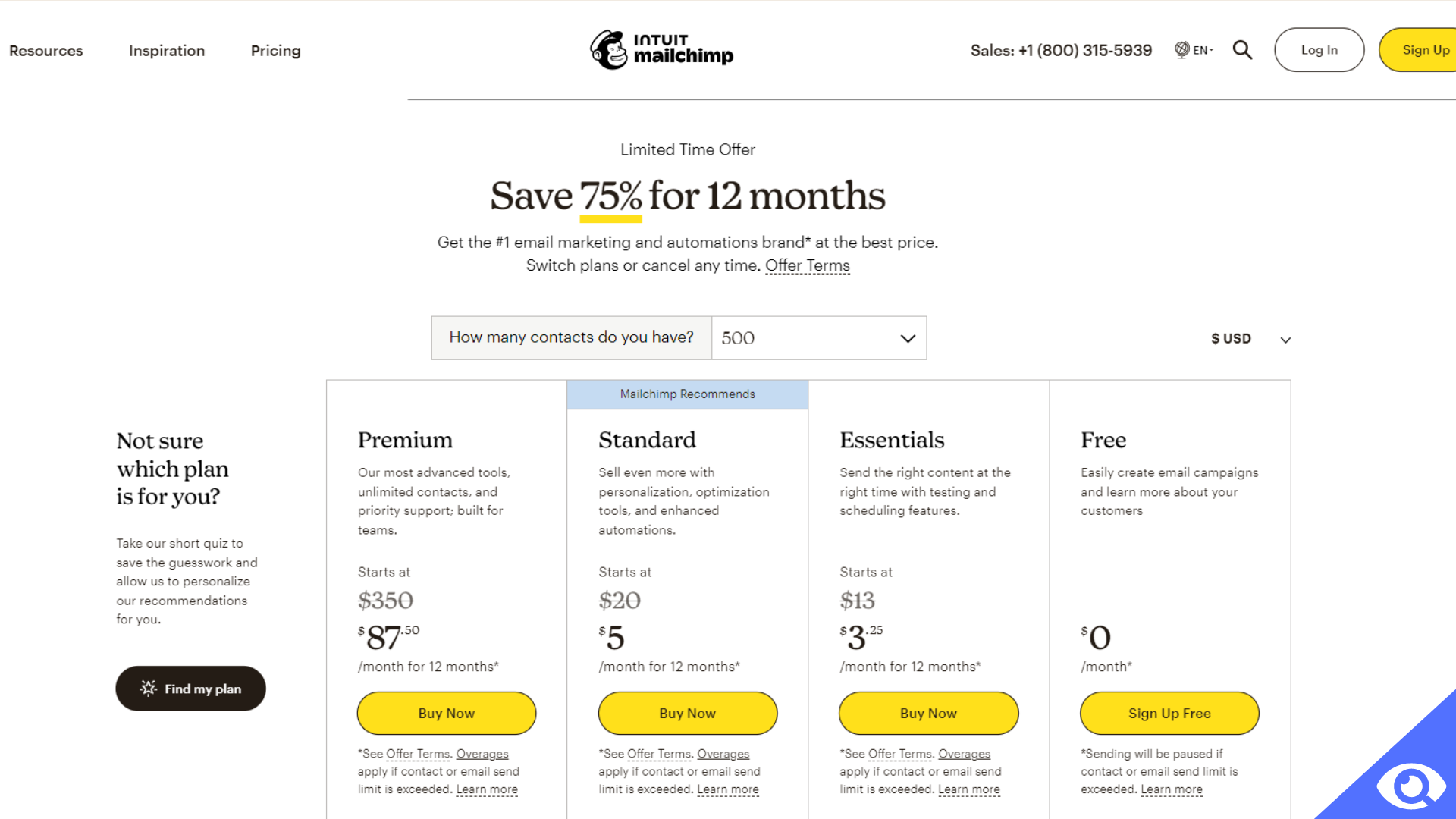
Mailchimp`s pricing (based on 9th August)
ActiveCampaign does not provide a free plan, but instead provides a 14-day free trial to assist customers in making a decision.
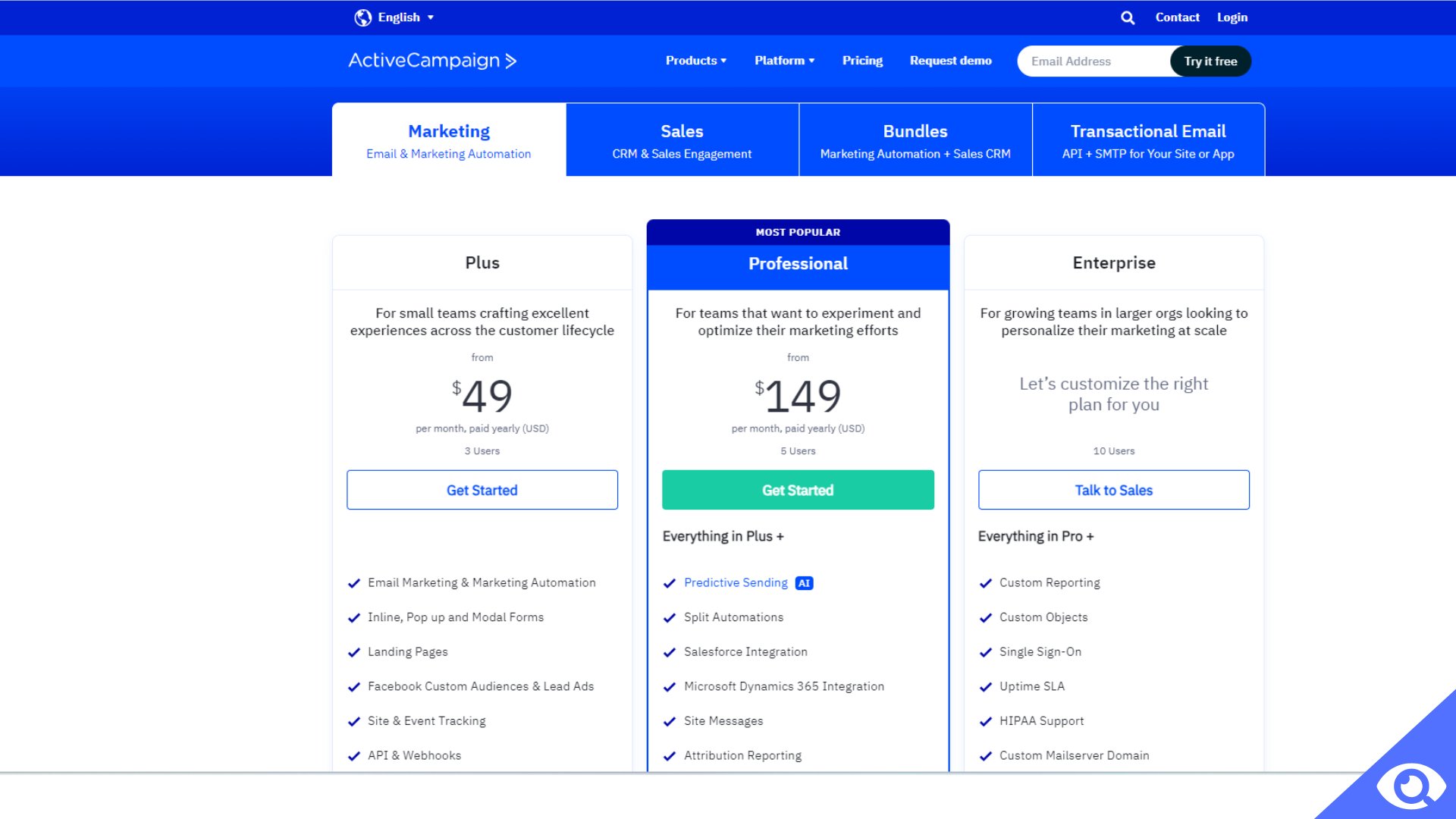
ActiveCampaign`s pricing (based on 9th August)
In this case, the ActiveCampaign versus Mailchimp verdict is that, for the most basic functionality, Mailchimp pricing is more affordable and preferable to ActiveCampaign.
ActiveCampaign, on the other hand, provides more bang for your buck for corporations looking for more extensive sales and marketing tools and functions.
[Related Article: 26 CRM Best Practices]
ActiveCampaign vs MailChimp: Make Your Decision!
When it comes to picking between ActiveCampaign and MailChimp, the right choice depends on your specific marketing requirements.
If you're aiming for a high level of sophistication and have the financial resources to support it, ActiveCampaign stands out as a clear recommendation.
However, let's consider a different scenario – one where budget constraints play a significant role, or where simplicity in usability takes precedence.
In such instances, MailChimp is the more suitable choice. If you find yourself in this category, it's advisable to make a purchase.
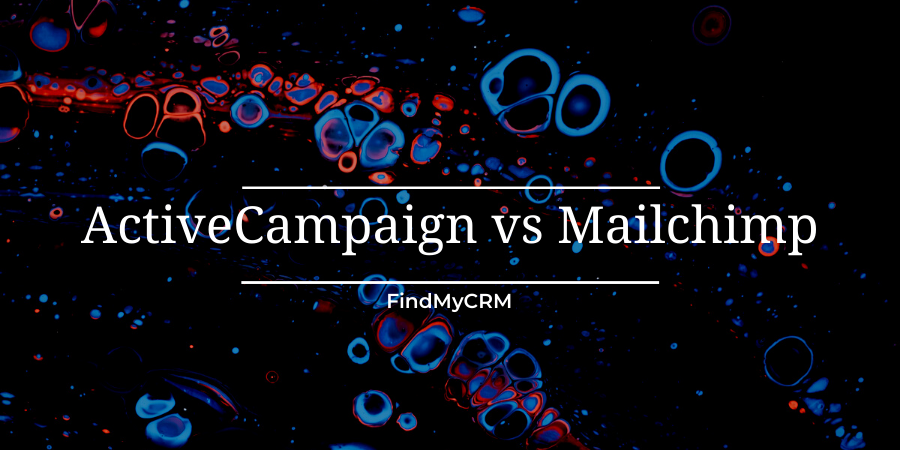
.png?width=140&height=140&name=Noah%20(1000%20x%201000%20px).png)
(2).jpg)

